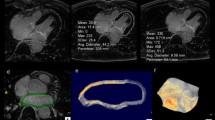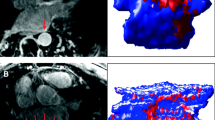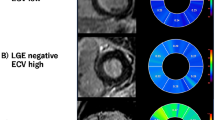Abstract
The complex fractioned atrial electrogram (CFAE) has been considered as the catheter ablation target of left atrium (LA) under persistent atrial fibrillation (PeAF). We evaluated the relation between the LA wall composition by late gadolinium enhancement cardiac magnetic resonance (LGE-CMR) and the CFAE in patients with PeAF. Forty-three patients underwent LGE-CMR and CFAE mapping before catheter ablation for PeAF. The LA wall substrates were classified into three: the fibrotic, intermediate, and normal substrates by using two thresholds of 2 standard deviation (2-SD) and 6-SD above the mean signal from the normal myocardium. For each of 12 preselected LA wall regions, the composition ratios (CRs) of fibrotic, indeterminate, and normal substrates were calculated as a percentage to the volume of LA wall region, and compared depending on the CFAE, respectively. The CR of normal substrate was significantly greater at the LA wall region with CFAE (52 ± 38 % vs. 20 ± 28 %, P < 0.01) than without CFAE. In contrast, the LA wall region with CFAE showed significantly lower CRs of intermediate substrate (39 ± 34 % vs. 57 ± 31 %, P < 0.01) and fibrotic substrate (7 ± 17 % vs. 21 ± 24 %, P < 0.01) than did the LA wall region without CFAE, respectively. Thus, the high CR (>18 %) of normal substrate predicted the CFAE at the corresponding LA wall region with 71 % sensitivity and 62 % specificity. In conclusion, the evaluation of LA wall normal substrate by LGE-CMR might be useful to predict the CFAE occurrence before catheter ablation of PeAF.







Similar content being viewed by others
References
Haissaguerre M, Sanders P, Hocini M et al (2005) Catheter ablation of long-lasting persistent atrial fibrillation: critical structures for termination. J Cardiovasc Electrophysiol 16(11):1125–1137
Oral H, Chugh A, Yoshida K et al (2009) A randomized assessment of the incremental role of ablation of complex fractionated atrial electrograms after antral pulmonary vein isolation for long-lasting persistent atrial fibrillation. J Am Coll Cardiol 53(9):782–789
Haissaguerre M, Jais P, Shah DC et al (1998) Spontaneous initiation of atrial fibrillation by ectopic beats originating in the pulmonary veins. N Engl J Med 339(10):659–666
Jais P, Haissaguerre M, Shah DC et al (1996) Regional disparities of endocardial atrial activation in paroxysmal atrial fibrillation. Pacing Clin Electrophysiol 19(11 Pt 2):1998–2003
Nademanee K, McKenzie J, Kosar E et al (2004) A new approach for catheter ablation of atrial fibrillation: mapping of the electrophysiologic substrate. J Am Coll Cardiol 43(11):2044–2053
Jadidi AS, Cochet H, Shah AJ et al (2013) Inverse relationship between fractionated electrograms and atrial fibrosis in persistent atrial fibrillation: combined magnetic resonance imaging and high-density mapping. J Am Coll Cardiol 62(9):802–812
Kanazawa H, Yamabe H, Enomoto K et al (2014) Importance of pericardial fat in the formation of complex fractionated atrial electrogram region in atrial fibrillation. Int J Cardiol 174(3):557–564
Kopecky SL, Gersh BJ, McGoon MD et al (1987) The natural history of lone atrial fibrillation. A population-based study over three decades. N Engl J Med 317(11):669–674
Wijffels MC, Kirchhof CJ, Dorland R et al (1995) Atrial fibrillation begets atrial fibrillation. A study in awake chronically instrumented goats. Circulation 92(7):1954–1968
Tanaka K, Zlochiver S, Vikstrom KL et al (2007) Spatial distribution of fibrosis governs fibrillation wave dynamics in the posterior left atrium during heart failure. Circ Res 101(8):839–847
Konings KT, Smeets JL, Penn OC et al (1997) Configuration of unipolar atrial electrograms during electrically induced atrial fibrillation in humans. Circulation 95(5):1231–1241
Lin J, Scherlag BJ, Zhou J et al (2007) Autonomic mechanism to explain complex fractionated atrial electrograms (CFAE). J Cardiovasc Electrophysiol 18(11):1197–1205
Kim RJ, Wu E, Rafael A et al (2000) The use of contrast-enhanced magnetic resonance imaging to identify reversible myocardial dysfunction. N Engl J Med 343(20):1445–1453
De Cobelli F, Pieroni M, Esposito A et al (2006) Delayed gadolinium-enhanced cardiac magnetic resonance in patients with chronic myocarditis presenting with heart failure or recurrent arrhythmias. J Am Coll Cardiol 47(8):1649–1654
Flett AS, Hasleton J, Cook C et al (2011) Evaluation of techniques for the quantification of myocardial scar of differing etiology using cardiac magnetic resonance. JACC Cardiovasc Imaging 4(2):150–156
Hwang SH, Choi EY, Park CH et al (2014) Evaluation of extracellular volume fraction thresholds corresponding to myocardial late-gadolinium enhancement using cardiac magnetic resonance. Int J Cardiovasc Imaging 30(Suppl 2):137–144
Henriksson KM, Farahmand B, Johansson S et al (2010) Survival after stroke—the impact of CHADS2 score and atrial fibrillation. Int J Cardiol 141(1):18–23
Verma A, Wazni OM, Marrouche NF et al (2005) Pre-existent left atrial scarring in patients undergoing pulmonary vein antrum isolation: an independent predictor of procedural failure. J Am Coll Cardiol 45(2):285–292
Oakes RS, Badger TJ, Kholmovski EG et al (2009) Detection and quantification of left atrial structural remodeling with delayed-enhancement magnetic resonance imaging in patients with atrial fibrillation. Circulation 119(13):1758–1767
Akkaya M, Higuchi K, Koopmann M et al (2013) Higher degree of left atrial structural remodeling in patients with atrial fibrillation and left ventricular systolic dysfunction. J Cardiovasc Electrophysiol 24(5):485–491
Badger TJ, Daccarett M, Akoum NW et al (2010) Evaluation of left atrial lesions after initial and repeat atrial fibrillation ablation: lessons learned from delayed-enhancement MRI in repeat ablation procedures. Circ Arrhythm Electrophysiol 3(3):249–259
Taclas JE, Nezafat R, Wylie JV et al (2010) Relationship between intended sites of RF ablation and post-procedural scar in AF patients, using late gadolinium enhancement cardiovascular magnetic resonance. Heart Rhythm 7(4):489–496
Malcolme-Lawes LC, Juli C, Karim R et al (2013) Automated analysis of atrial late gadolinium enhancement imaging that correlates with endocardial voltage and clinical outcomes: a 2-center study. Heart Rhythm 10(8):1184–1191
Malcolme-Lawes SH, Oh YW, Lee DI et al (2014) Evaluation of quantification methods for left arial late gadolinium enhancement based on different references in patients with atrial fibrillation. Int J Cardiovasc Imaging. doi:10.1007/s10554-014-0563-0
Schmidt M, Dorwarth U, Andresen D et al (2014) Cryoballoon versus RF ablation in paroxysmal atrial fibrillation: results from the German Ablation Registry. J Cardiovasc Electrophysiol 25(1):1–7
Ho SY, Anderson RH, Sanchez-Quintana D (2002) Atrial structure and fibres: morphologic bases of atrial conduction. Cardiovasc Res 54(2):325–336
Atienza F, Calvo D, Almendral J et al (2011) Mechanisms of fractionated electrograms formation in the posterior left atrium during paroxysmal atrial fibrillation in humans. J Am Coll Cardiol 57(9):1081–1092
Park JH, Park SW, Kim JY et al (2010) Characteristics of complex fractionated atrial electrogram in the electroanatomically remodeled left atrium of patients with atrial fibrillation. Circ J 74(8):1557–1563
Conflict of interest
None.
Author information
Authors and Affiliations
Corresponding author
Rights and permissions
About this article
Cite this article
Hwang, S.H., Oh, YW., Lee, D.I. et al. Relation between left atrial wall composition by late gadolinium enhancement and complex fractionated atrial electrograms in patients with persistent atrial fibrillation: influence of non-fibrotic substrate in the left atrium. Int J Cardiovasc Imaging 31, 1191–1199 (2015). https://doi.org/10.1007/s10554-015-0675-1
Received:
Accepted:
Published:
Issue Date:
DOI: https://doi.org/10.1007/s10554-015-0675-1




